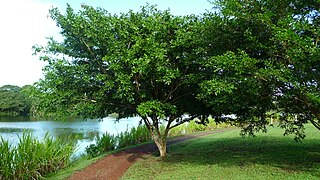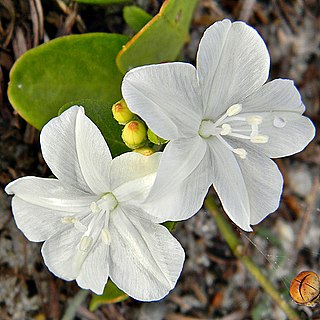
The Mimosoideae are a traditional subfamily of trees, herbs, lianas, and shrubs in the pea family (Fabaceae) that mostly grow in tropical and subtropical climates. They are typically characterized by having radially symmetric flowers, with petals that are twice divided (valvate) in bud and with numerous showy, prominent stamens.

Abutilon is a large genus of flowering plants in the mallow family, Malvaceae. It is distributed throughout the tropics and subtropics of the Americas, Africa, Asia, and Australia. General common names include Indian mallow and velvetleaf; ornamental varieties may be known as room maple, parlor maple, or flowering maple. The genus name is an 18th-century Neo-Latin word that came from the Arabic ’abū-ṭīlūn, the name given by Avicenna to this or a similar genus.

Myrica is a genus of about 35–50 species of small trees and shrubs in the family Myricaceae, order Fagales. The genus has a wide distribution, including Africa, Asia, Europe, North America and South America, and missing only from Australia. Some botanists split the genus into two genera on the basis of the catkin and fruit structure, restricting Myrica to a few species, and treating the others in Morella.

Leucaena leucocephala is a small fast-growing mimosoid tree native to southern Mexico and northern Central America and is now naturalized throughout the tropics including parts of Asia.

Mimosine or leucenol is a toxic non-protein amino acid chemically similar to tyrosine. It occurs in some Mimosa spp. and all members of the closely related genus Leucaena.

Pithecellobium is a genus of flowering plants in the family Fabaceae. It includes approximately 23 species from the tropical Americas, ranging from Mexico to Peru and northern Brazil, including the Caribbean Islands and Florida.

Swartzia is a genus of flowering plants in the family Fabaceae. It was named in honor of Swedish botanist Olof Swartz and contains about 200 species. Swartzia is restricted in its geographical distribution to the New World Tropics, where it occurs primarily in lowland rainforests, but also in savannas, pre-montane forests, and tropical dry forests. While it can be found throughout the wet lowlands from Mexico and the Caribbean islands to southern Brazil and Bolivia, Swartzia is most abundant and species-rich in Amazonia, where 10–20 species may co-occur at a single site. The species of Swartzia are mostly trees, ranging from small understory treelets to large canopy emergents. Some species, especially in savannas, are mult-stemmed shrubs.

Tephrosia is a genus of flowering plants in the family Fabaceae. It is widespread in both the Eastern and Western Hemisphere, where it is found in tropical and warm-temperate regions.

Zygia is a genus of flowering plants in the family Fabaceae. It includes 60 species of tres and shrubs native to the tropical Americas, from Southern Mexico and Cuba to northern Argentina. Typical habitats are tropical forest and coastal zones, generally below 900 meters elevation with a few species extending up to 2800 meters. It belongs to the mimosoid clade of the subfamily Caesalpinioideae.

Aeschynomene is a genus of flowering plants in the family Fabaceae, and was recently assigned to the informal monophyletic Dalbergia clade of the Dalbergieae. They are known commonly as jointvetches. They range across tropical and subtropical regions of the Americas, sub-Saharan Africa, south, southeast, and east Asia, and Australia. These legumes are most common in warm regions and many species are aquatic.

Hoffmannseggia is a genus of flowering plants in the pea family, Fabaceae, known generally as rushpeas. These are pod-bearing herbs and subshrubs native to the Americas. In North America they range from California and Nebraska to southern Mexico, and from Colombia, Ecuador, and Peru to southern Argentina and Chile in South America. The generic name honors Johann Centurius, Count of Hoffmannsegg, a nineteenth-century German nobleman and botanist.

Lysiloma is a genus of flowering plants in the family Fabaceae.

Hernandia is a genus of flowering plants in the family Hernandiaceae. It was named after the Spanish botanist Francisco Hernández de Toledo.

Spigelia is a genus of flowering plants in the family Loganiaceae. It contains around 60 species, distributed over the warmer parts of the Americas, from the latitude of Buenos Aires to the Southern United States. It was named after Adriaan van den Spiegel by Carl Linnaeus in his 1753 Species Plantarum; the type species is Spigelia anthelmia. Pinkroot is a common name for plants in this genus.

Jacquemontia is a genus of plants in the morning glory family Convolvulaceae. Species in this genus are commonly known as clustervine.
Erythrostemon is a genus of flowering plants in the legume family, Fabaceae. Its native range is tropical & subtropical America.

Libidibia is a genus of flowering plants in the family Fabaceae. It includes seven species of trees and shrubs native to the tropical Americas, ranging from northern Mexico to northern Argentina. Typical habitats include seasonally-dry tropical forest and scrub, thorn forest, and savanna woodland. It belongs to the subfamily Caesalpinioideae.

Leucaena diversifolia, the wild tamarind or red leucaena, is a species of flowering plant in the family Fabaceae, native to Mexico and Central America. It has been introduced as a cattle fodder in many tropical and subtropical locales around the world. It and its hybrid with Leucaena leucocephala are as aggressively invasive as L. leucocephala itself.
Neltuma is a genus of flowering plants in the pea family (Fabaceae). It includes 43 species native to the Americas. The species range from the southwestern and central United States through Mexico, Central America, the Caribbean, and South America to southern Argentina.

















